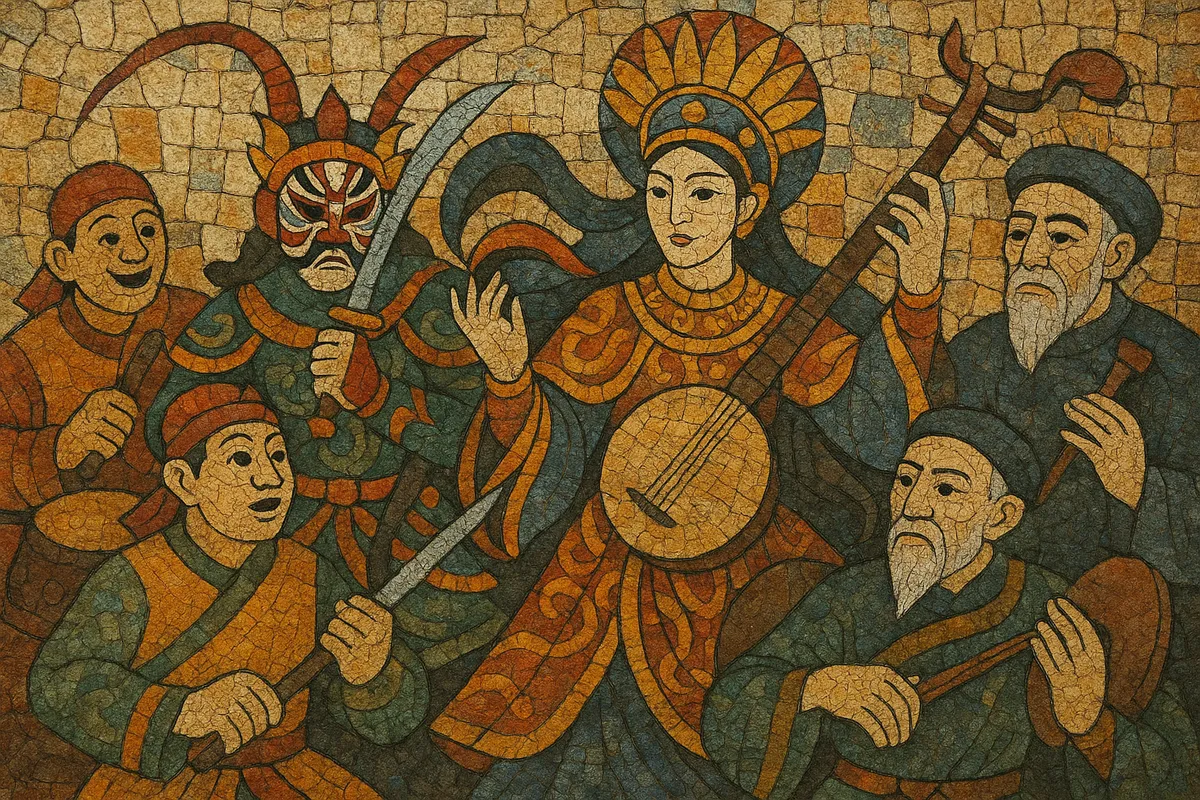Hát tuồng (also called hát bội) is Vietnam’s classical court opera, a highly stylized form of sung drama that blends heroic storytelling, ritualized gesture, and martial dance. Performances feature codified role types, elaborate costumes, and bold face-paint designs that signal character archetypes such as the young male lead (sinh/kép), the female lead (đào), the old man (lão), the clown (hề), and painted-face warriors.
Musically, tuồng employs pentatonic modes, flexible speech-song delivery (nói lối/recitative) interwoven with lyrical arias, and an energetic percussion-led ensemble. Its orchestra typically includes double-reed shawm (kèn bầu), two-string fiddles (đàn nhị/đàn cò), moon lute (đàn nguyệt), drums (trống chầu, trống chiến), cymbals, and gongs, creating a bright, penetrating sound that coordinates drama and movement. Stories draw on dynastic history, moral dilemmas, and legendary exploits, using poetic Vietnamese and Sino-Vietnamese diction.
Staging is symbolic and minimalist: stylized props, choreographed footwork, and codified gestures depict battles, journeys, and palatial spaces, while percussion cues punctuate entrances, emotions, and scene changes. The result is an epic, ceremonially charged theater that balances grandeur with moral clarity.
According to Vietnamese chronicles, tuồng took root in the 13th century when a Chinese performer known as Lý Nguyên Cát is said to have introduced court drama practices to Đại Việt. Early tuồng was cultivated in royal and aristocratic circles, where it absorbed classical music aesthetics and ritual etiquette.
Under the Nguyễn lords and later the Nguyễn dynasty, tuồng flourished as a courtly art, especially in Huế. Repertoires were codified, role types and face-paint conventions standardized, and orchestral forces formalized. Major playwrights and reformers such as Đào Duy Từ and Đào Tấn consolidated musical-modal practices (Bắc/Nam flavors, recitative bridges) and dramaturgy (heroic epics, moral conflicts), producing canonical pieces performed by elite troupes.
As court troupes interacted with local performers, regional schools emerged (notably the Bình Định tradition), and performances expanded beyond the court to festivals and urban theaters. Percussion-led cueing systems, martial choreography, and symbolic staging became signatures, making tuồng both ceremonial and accessible to broader audiences.
In the early 20th century, new popular forms (notably cải lương in the south) and modern media drew audiences away from court opera. Tuồng entered a period of contraction, but state theaters, conservatories, and scholars preserved and revitalized it through documentation, staged revivals, and pedagogy. Today, institutions such as the Vietnam Tuong Theatre and regional troupes maintain a living tradition through repertoire restoration, artist training, and contemporary adaptations.


